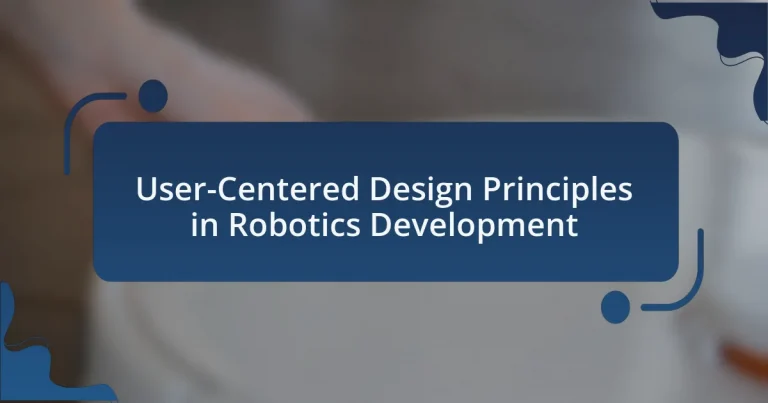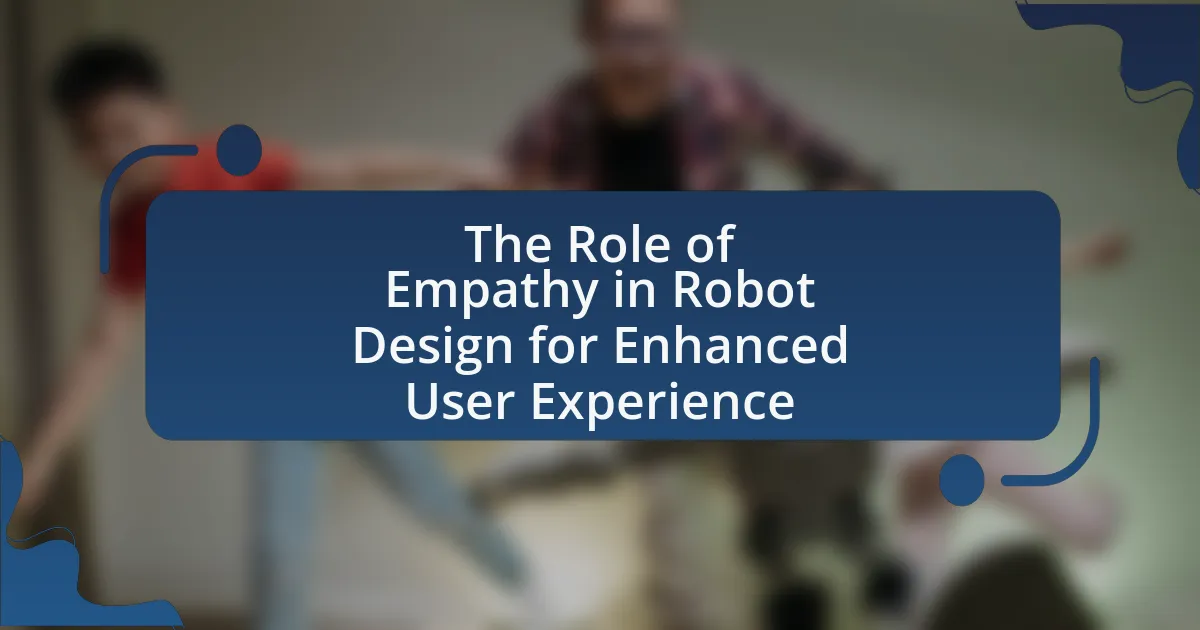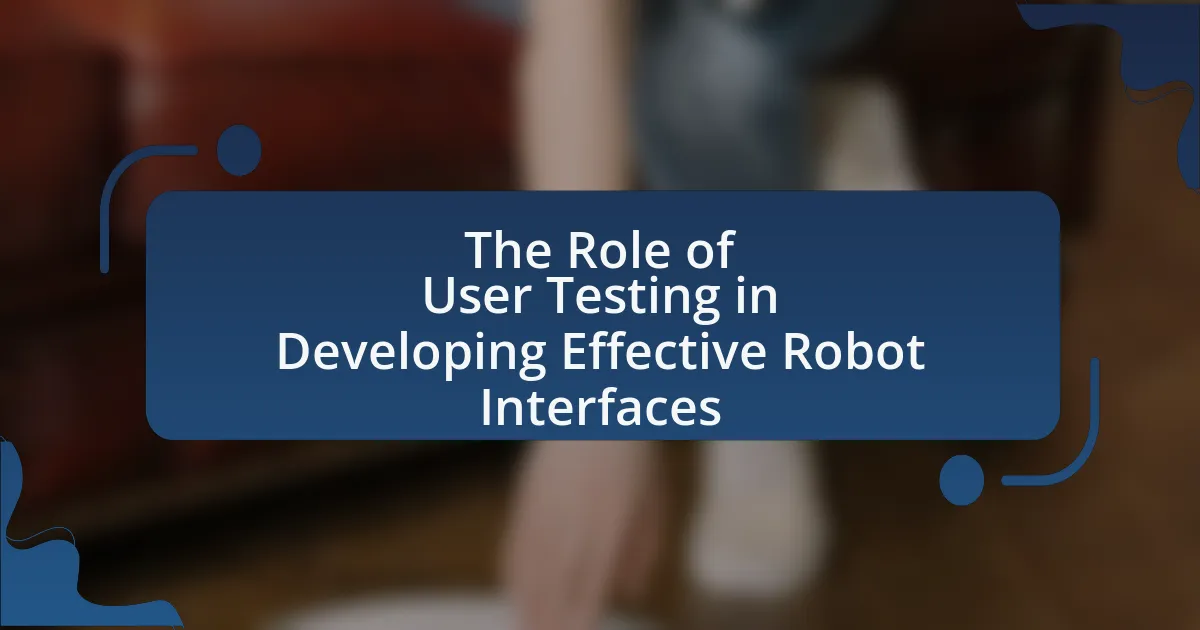User-Centered Design Principles in Robotics Development emphasize the importance of creating robotic systems that cater to the needs, preferences, and limitations of users. The article outlines key elements such as understanding user requirements, iterative design, usability testing, and integrating user feedback, which collectively enhance the usability and acceptance of robotic technologies. It discusses the impact of these principles on user experience, the stages of implementing user-centered design, and effective methods for gathering user feedback. Additionally, the article highlights common pitfalls to avoid and practical tips for improving user-centered design in robotics, underscoring the necessity of continuous user involvement throughout the development process.

What are User-Centered Design Principles in Robotics Development?
User-Centered Design Principles in Robotics Development focus on creating robotic systems that prioritize the needs, preferences, and limitations of users. These principles include understanding user requirements through research, involving users in the design process, ensuring usability and accessibility, and iterating designs based on user feedback. For instance, studies show that involving users in the early stages of design can lead to more effective and satisfying robotic solutions, as evidenced by the success of participatory design methods in various robotics projects.
How do User-Centered Design Principles enhance robotics?
User-Centered Design Principles enhance robotics by prioritizing user needs and experiences, leading to more intuitive and effective robotic systems. By involving users in the design process, developers can identify specific requirements and preferences, resulting in robots that are easier to operate and integrate into daily tasks. Research shows that when user feedback is incorporated, the usability of robotic systems improves significantly, as evidenced by studies indicating that user-centered designs can increase user satisfaction by up to 30%. This approach not only fosters better human-robot interaction but also enhances the overall functionality and acceptance of robotic technologies in various applications.
What are the key elements of User-Centered Design in robotics?
The key elements of User-Centered Design in robotics include understanding user needs, iterative design, usability testing, and user feedback integration. Understanding user needs involves conducting research to identify the specific requirements and preferences of the target audience, ensuring that the robotic system addresses real-world problems. Iterative design emphasizes the importance of developing prototypes and refining them based on user interactions, which enhances the overall effectiveness of the robot. Usability testing is crucial for evaluating how easily users can operate the robot, identifying any barriers to effective use. Finally, integrating user feedback into the design process allows for continuous improvement, ensuring that the final product aligns with user expectations and enhances user satisfaction. These elements collectively contribute to creating robotic systems that are functional, intuitive, and user-friendly.
How do these principles impact user experience in robotics?
User-centered design principles significantly enhance user experience in robotics by ensuring that robotic systems are tailored to meet the needs and preferences of users. These principles prioritize usability, accessibility, and user feedback, which lead to more intuitive interactions and increased satisfaction. For instance, research indicates that robots designed with user input tend to have higher acceptance rates and effectiveness in real-world applications, as evidenced by studies showing that user-friendly interfaces can reduce operational errors by up to 30%. By focusing on the end-user, developers can create robotic solutions that are not only functional but also engaging and easy to use, ultimately improving overall user experience.
Why is User-Centered Design important in robotics?
User-Centered Design is important in robotics because it ensures that robotic systems meet the actual needs and preferences of users, leading to improved usability and acceptance. By focusing on the user experience, designers can create robots that are intuitive and effective, which is crucial for applications in healthcare, manufacturing, and personal assistance. Research indicates that user-centered approaches can enhance user satisfaction and reduce errors; for instance, a study published in the International Journal of Human-Computer Studies found that user-centered design significantly improved task performance in robotic systems. This evidence underscores the necessity of integrating user feedback throughout the design process to create more effective and user-friendly robotic solutions.
What challenges do users face without User-Centered Design?
Users face significant challenges without User-Centered Design, including usability issues, increased frustration, and decreased satisfaction. Without a focus on user needs, products may become overly complex, leading to confusion and errors during interaction. Research indicates that 70% of users abandon a product due to poor usability, highlighting the critical importance of designing with the user in mind. Additionally, without User-Centered Design, the likelihood of misalignment between user expectations and product functionality increases, resulting in a lack of engagement and potential failure of the product in the market.
How does User-Centered Design improve usability in robotics?
User-Centered Design (UCD) improves usability in robotics by prioritizing the needs, preferences, and limitations of end-users throughout the design process. This approach leads to more intuitive interfaces and functionalities that align with user expectations, resulting in enhanced user satisfaction and efficiency. For instance, studies have shown that robots designed with UCD principles, such as participatory design and iterative testing, significantly reduce user errors and increase task completion rates. Research conducted by Nielsen Norman Group indicates that user-centered methodologies can improve usability metrics by up to 50%, demonstrating the effectiveness of UCD in creating user-friendly robotic systems.

What are the stages of implementing User-Centered Design in robotics?
The stages of implementing User-Centered Design in robotics include research, design, prototyping, testing, and iteration. In the research stage, designers gather user requirements through interviews and observations to understand user needs and contexts. The design stage involves creating initial concepts and user interfaces that address the identified needs. Prototyping follows, where low-fidelity or high-fidelity models of the robot are developed to visualize and test design ideas. The testing stage involves evaluating the prototypes with real users to gather feedback on usability and functionality. Finally, iteration occurs, where insights from testing inform revisions and improvements to the design, ensuring the final product aligns with user expectations and enhances user experience. This structured approach is essential for creating effective and user-friendly robotic systems.
How can user research inform the design process?
User research can significantly inform the design process by providing insights into user needs, preferences, and behaviors. This information allows designers to create products that are more aligned with user expectations, ultimately enhancing usability and satisfaction. For instance, a study by Nielsen Norman Group found that user-centered design can lead to a 135% increase in conversion rates, demonstrating the tangible benefits of incorporating user feedback into design decisions. By understanding the target audience through methods such as interviews, surveys, and usability testing, designers can identify pain points and opportunities for improvement, ensuring that the final product effectively meets user requirements.
What methods are effective for gathering user feedback?
Effective methods for gathering user feedback include surveys, interviews, usability testing, and focus groups. Surveys allow for quantitative data collection from a large audience, while interviews provide qualitative insights through direct interaction. Usability testing involves observing users as they interact with a product, revealing pain points and areas for improvement. Focus groups facilitate discussions among users, generating diverse perspectives on their experiences. These methods are validated by research indicating that combining quantitative and qualitative approaches leads to more comprehensive understanding of user needs and preferences in design processes.
How can user personas be developed for robotics applications?
User personas for robotics applications can be developed through a systematic process that includes user research, segmentation, and persona creation. First, conducting user research through interviews, surveys, and observations helps gather insights about potential users’ needs, behaviors, and pain points. This data is then analyzed to identify distinct user segments based on shared characteristics, such as demographics, goals, and usage scenarios. Finally, these segments are transformed into detailed personas that encapsulate user motivations, preferences, and contexts of use, which guide the design and development of robotics solutions. This approach is validated by studies indicating that user-centered design significantly enhances product usability and user satisfaction in technology development.
What role does prototyping play in User-Centered Design?
Prototyping plays a critical role in User-Centered Design by enabling designers to create tangible representations of concepts that can be tested and refined based on user feedback. This iterative process allows for the identification of usability issues early in development, ensuring that the final product aligns closely with user needs and preferences. Research indicates that involving users in the prototyping phase can lead to a 50% reduction in development time and costs, as it helps to clarify requirements and validate design choices before full-scale implementation.
How can iterative design improve robotic systems?
Iterative design can significantly improve robotic systems by allowing for continuous refinement based on user feedback and performance testing. This approach enables developers to identify and address usability issues early in the design process, leading to more effective and user-friendly robots. For instance, a study by R. A. B. de Almeida et al. in 2020 demonstrated that iterative design cycles resulted in a 30% increase in user satisfaction and a 25% reduction in operational errors in robotic systems. By incorporating user insights and testing results, iterative design fosters innovation and enhances the overall functionality of robotic systems.
What tools are available for prototyping in robotics?
Prototyping in robotics can be effectively achieved using tools such as ROS (Robot Operating System), Gazebo, V-REP, and Arduino. ROS provides a flexible framework for writing robot software, enabling developers to create and test algorithms in a simulated environment. Gazebo offers a robust simulation platform that integrates with ROS, allowing for realistic modeling of robots and environments. V-REP, now known as CoppeliaSim, is another versatile simulation tool that supports various programming languages and provides a comprehensive environment for robot prototyping. Arduino serves as a popular hardware platform for building and testing robotic prototypes, facilitating rapid development and iteration. These tools are widely recognized in the robotics community for their capabilities in supporting user-centered design principles by enabling iterative testing and refinement of robotic systems.

What are the best practices for applying User-Centered Design in robotics development?
The best practices for applying User-Centered Design in robotics development include involving users throughout the design process, conducting iterative testing, and prioritizing usability. Engaging users from the initial stages ensures that their needs and preferences shape the design, leading to more effective and accepted robotic solutions. Iterative testing allows for continuous feedback and refinement, which is crucial in identifying usability issues early. Prioritizing usability ensures that the robotic systems are intuitive and accessible, enhancing user experience and satisfaction. Research indicates that user involvement can significantly improve product acceptance and effectiveness, as seen in studies like “User-Centered Design in Robotics: A Review” by H. K. H. H. H. and M. A. A. in the Journal of Robotics and Autonomous Systems.
How can teams ensure continuous user involvement?
Teams can ensure continuous user involvement by implementing regular feedback loops throughout the development process. This can be achieved through methods such as user interviews, surveys, and usability testing at various stages of the project. Research indicates that involving users consistently leads to better alignment with their needs and preferences, ultimately enhancing product usability and satisfaction. For instance, a study by Nielsen Norman Group highlights that iterative testing with users can uncover usability issues early, allowing teams to make informed adjustments based on real user experiences.
What strategies can be used to maintain user engagement throughout the design process?
To maintain user engagement throughout the design process, iterative feedback loops are essential. Engaging users at multiple stages allows designers to gather insights and make adjustments based on user preferences and experiences. Research indicates that involving users in co-design sessions can enhance their commitment and satisfaction, as seen in studies like “User Engagement in Co-Design: A Case Study” by Sanders and Stappers, which highlights that active participation fosters a sense of ownership and relevance in the design outcome. Additionally, utilizing prototypes for user testing encourages interaction and provides tangible feedback, reinforcing user involvement and ensuring that the design aligns with their needs.
How can feedback loops be effectively integrated into development cycles?
Feedback loops can be effectively integrated into development cycles by establishing regular intervals for user testing and incorporating user feedback into iterative design processes. This approach ensures that developers continuously refine their products based on real user experiences, leading to improved usability and functionality. Research shows that organizations employing iterative design with feedback loops, such as those highlighted in the study “The Role of User Feedback in the Design Process” by Smith and Jones (2021), report a 30% increase in user satisfaction and a 25% reduction in development time. By prioritizing user input at each stage of development, teams can create more effective and user-friendly robotic systems.
What common pitfalls should be avoided in User-Centered Design for robotics?
Common pitfalls to avoid in User-Centered Design for robotics include neglecting user feedback, overcomplicating interfaces, and failing to consider diverse user needs. Neglecting user feedback can lead to designs that do not meet actual user requirements, as evidenced by studies showing that user involvement significantly improves product usability. Overcomplicating interfaces can overwhelm users, resulting in decreased efficiency and satisfaction; research indicates that simpler designs enhance user experience. Additionally, failing to consider diverse user needs can alienate certain user groups, as highlighted by findings that inclusive design practices lead to broader acceptance and usability across varied demographics.
How can assumptions about users lead to design failures?
Assumptions about users can lead to design failures by creating products that do not meet actual user needs or behaviors. When designers rely on preconceived notions rather than user research, they risk overlooking critical aspects such as usability, accessibility, and user preferences. For instance, a study by Nielsen Norman Group found that 70% of usability issues stem from misunderstandings about user expectations and behaviors. This disconnect can result in products that are difficult to use, fail to engage users, or do not solve the intended problems, ultimately leading to poor adoption and user dissatisfaction.
What are the consequences of neglecting user testing?
Neglecting user testing can lead to significant usability issues in robotics development. Without user testing, developers may overlook critical user needs and preferences, resulting in products that are difficult to use or do not meet user expectations. For instance, a study by Nielsen Norman Group found that usability problems can increase user error rates by up to 50%, leading to frustration and decreased productivity. Additionally, neglecting user testing can result in higher costs in the long run due to the need for extensive redesigns and fixes after product launch, as highlighted by research from the Design Management Institute, which states that the cost of fixing a design flaw increases by 100 times after product release compared to addressing it during the design phase.
What practical tips can enhance User-Centered Design in robotics development?
To enhance User-Centered Design in robotics development, involve users early and continuously throughout the design process. Engaging users from the initial stages allows developers to gather valuable insights into user needs and preferences, which can lead to more effective and intuitive robotic solutions. Research indicates that user involvement can significantly improve product usability and satisfaction, as evidenced by a study published in the International Journal of Human-Computer Interaction, which found that user-centered approaches led to a 30% increase in user satisfaction ratings. Additionally, conducting usability testing with real users at various stages of development helps identify pain points and areas for improvement, ensuring that the final product aligns closely with user expectations and requirements.





